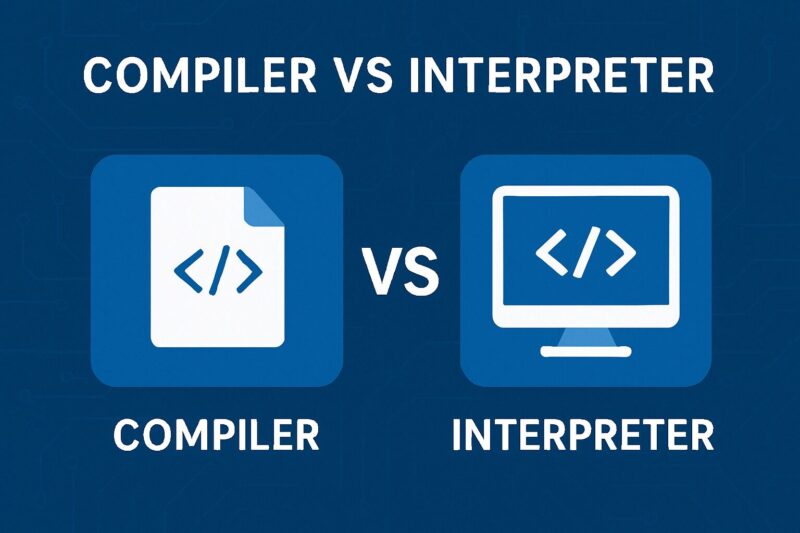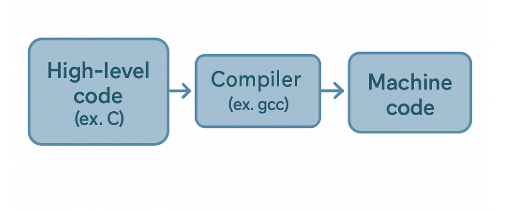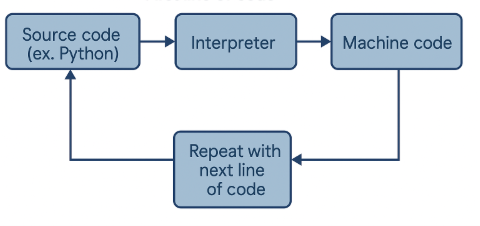
When you write a program in a high-level language like Python or C++, you are using something that makes sense to us as humans, but not to your computer. It’s similar to speaking a language the machine does not understand. Before your code can run, it needs to be translated into a form the computer can interpret. That’s where language processors come in. They take your human-readable code and convert it into machine code that the system can execute. There are two main types of language processors that handle this translation: compilers and interpreters, each working in a different way to help the machine understand your instructions.
What is a Compiler?
A compiler is a program that takes all of your source code and translates it into a separate file made up of machine code. This machine code is what your computer’s hardware can understand and run directly. For instance, if you wrote your code in C, you could use a compiler like gcc to turn that code into something the computer can execute. Once the translation is done, the compiled file is ready to run without needing the original source code every time.

However, turning source code into machine-readable instructions is not something that happens all at once. A compiler has to work through several phases to complete the translation process.
Lexical Analysis
In the lexical analysis phase, the compiler starts by breaking your code into smaller pieces called lexemes. These are little chunks that match certain patterns in the language. For example, in a line like int num = 5;, the lexemes would be int, num, =, 5, and ;. Once the compiler identifies these pieces, it groups them into tokens. Tokens are meaningful units that help the compiler understand the structure of your code and get it ready for the next steps in the compilation process.
Syntax Analysis
In this phase, the compiler takes the tokens created during lexical analysis and checks whether the code follows the correct syntax. It does this by building something called an abstract syntax tree, which represents the structure and logic of the code. If the code breaks any of the language’s grammar rules, the compiler reports a syntax error. For example, if you write int num == 5;, the compiler will flag it as incorrect because == is not valid in that context. The compiler expects a single equals sign when assigning a value, not a comparison operator.
Semantic Analysis
The purpose of semantic analysis is to make sure the code actually makes sense. At this stage, the compiler checks whether things are being used the right way. For example, it verifies that variables are declared with the correct types and that control structures or labels are used properly. This step helps confirm that the code is not just written correctly, but that it also behaves the way it is supposed to based on the logic behind it.
Intermediate Code Generation
Once the code makes it through the analysis stages, the compiler turns it into an intermediate form. This version is not tied to any specific machine and acts like a universal blueprint for the program. It helps make the code more portable, so it can later be adapted to run on different types of hardware without starting from scratch.
Optimization
At this stage, the compiler focuses on improving how well the code runs. This process, called optimization, might involve reducing how much memory the program uses, making better use of the CPU, or simply running things faster. The goal is to make the final program as efficient as possible without changing what it is meant to do.
Output Code Generation
In the last step of the compilation process, the compiler takes the optimized intermediate version of the code and translates it into machine code tailored for the target system. The result is a fully executable file that can run on the machine without needing any additional translation.
What is an Interpreter?
An interpreter, like a compiler, is a program that translates high-level code into something the machine can understand. The key difference is in how it handles that translation. While a compiler translates the entire codebase before anything runs, an interpreter works line by line. It starts at the first line of code and translates each one as the program runs, handling everything in real time.

If the interpreter runs into an error in a specific line, it stops right there and waits for the issue to be fixed. Because it translates the code in real time, the program takes longer to run compared to one compiled ahead of time. Still, this method has a big advantage. Since the interpreter goes through the code one line at a time, it stops exactly where the problem is, which makes it much easier for developers to find and fix mistakes. On the other hand, a compiler looks at the entire program all at once. It does report errors, but those messages may not always make it obvious where the issue actually lives in the code.
Advantages and Disadvantages of the Language Processors
Compilers and interpreters both aim to do the same core job: turning high-level programming languages into machine language that a computer can understand. But they each come with their own set of strengths and trade-offs. One of the biggest advantages of using a compiler is speed. Since the entire program is translated into machine code ahead of time, it runs much faster once it starts. This makes compilers a strong choice for performance-focused applications.
Interpreters, on the other hand, offer more flexibility and make debugging easier. They translate and run the code one line at a time, which means they stop immediately when something goes wrong. This helps developers quickly pinpoint the issue without digging through the entire codebase. The downside is that interpreted programs generally run more slowly, since each line has to be translated every time the program runs. While compilers can catch all the errors before execution, they sometimes give messages that are harder to trace back to a specific problem. Interpreters make it much clearer where the error is, which can be a big help during development.